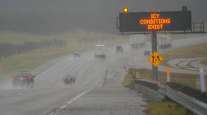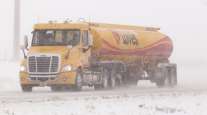Fleets Take Precautions to Keep Equipment Running in Extreme Weather

[Stay on top of transportation news: Get TTNews in your inbox.]
As temperatures drop, drivers and technicians have to take extra precautions to ensure equipment operates properly and everyone remains safe. Air systems, fuel and diesel particulate filters are among the items requiring special attention when extreme weather hits, but those within the industry said getting ready for cold temperatures is a year-round effort.
“There are things you should be doing all year long regardless of winter,” said Dan Carrano, vice president of fleet maintenance for A. Duie Pyle.
Mark Swift, Penske Truck Leasing’s vice president of field maintenance for the north-central region, said large fleets don’t have time to wait until cold hits to prepare vehicles.
RELATED: Treatments, Tools Help Fleets Battle Corrosion, Snow Accumulation
“We have 327,000 pieces of equipment on the road. If I had to do all of that at one time in winter, it would be impossible,” he said, adding that Penske ramps up preparation in September. “It goes back to making sure our locations and our fuel islands are prepped.”
Jeff Rogers, director of field maintenance for Ryder, said the company focuses on maintaining vehicles year-round but also emphasizes a quality inspection process in the fourth quarter as winter nears. “Severe cold is a very serious thing,” he said.
American Trucking Associations’ Technology & Maintenance Council has several recommendations for how fleets should prepare equipment for winter weather and colder temperatures, including RP 311A, Cold Weather Operation. The recommended practice includes a cold-weather operations maintenance checklist that covers 15 areas.
A. Duie Pyle’s Carrano said a properly functioning air system is one of the most critical components in the winter, especially with some of the new technology, such as automated transmissions.

In our third episode of RoadSigns, Season Five, we ask: How Can Trucking Raise The Bar For Freight Visibility? Hear a snippet, above, and get the full program by going to RoadSigns.TTNews.com.
“If you get moisture in the air system, valves don’t function,” he said, adding that caring for air systems is a 12-month process. “The tolerance in the systems is very precise, and any moisture causes failure, not just in the winter.”
As part of its preventive maintenance program, A. Duie Pyle, which is based in West Chester, Pa., and ranks No. 75 on the Transport Topics Top 100 list of the largest for-hire carriers in North America, replaces the complete air dryer assembly. Some fleets only replace the desiccant cartridge. Carrano said the carrier has next to zero air filter system failures, so the extra cost is worth it.
Ryder’s Rogers said air lines are in danger of losing flexibility and separating if they aren’t maintained.
“We use cold weather resistant air lines in our northern states,” he said. “They don’t lose their flexibility and crack and separate.”
Drivers can help maintain air systems by draining air tanks daily, said Tim Moore, vice president of TMcare operations for FleetNet America, an ArcBest company. ArcBest ranks No. 14 on the for-hire TT100.
He explained that moisture gathers in the air systems’ reservoir tanks due to condensation.
“Air tanks have pull cords,” he said. “All you have to do daily is give a quick pull on your tractor and trailer air tanks, and it releases that moisture out of that tank.”
Drivers’ pre- and post-trip inspections are essential to safety and performance, especially in the winter.
“You can’t do a quick pre-trip. You have to pay attention to those critical checkpoints,” Penske’s Swift said. “If you have ice or snow on the lines, you still have to do a quality pre-trip and post-trip.”
Scott Allen, director of fleet assets and maintenance for Dupré Logistics, which is based in Lafayette, La., said drivers also should pay special attention to tire pressure and air lines when doing pre-trip inspections.
“Changes in temp can drastically change air pressure in tires and in pressuring up the tanks,” he said.
Carrano said A. Duie Pyle’s biggest challenges are related to the exhaust aftertreatment systems, especially in the coldest months.
“A requirement of the functionality of the aftertreatment is heat,” he said. “In the cold months, it is sometimes hard for the system to reach the necessary temperatures to burn the soot and turn it into ash.”
Due to varying duty cycles and low ambient temperatures, an active regeneration strategy is required to ensure proper performance of the aftertreatment system, TMC Executive Director Robert Braswell said.
“Extended idle at cold temperatures will require more frequent active regens, and [fleets] may see increased DPF plugging,” he said.
Swift said drivers need to pay attention to their dashes.
“If the truck asks for a regen, do it when it asks,” he said, adding that a parked or active regen can generate enough heat to burn off the soot. “You have to pay attention to what the truck is telling you.”
Diesel exhaust fluid can freeze, but the system is designed to compensate for frozen DEF, which can’t be injected into the selective catalytic converter and won’t throw any fault codes. The challenge, however, is that the DEF tank doesn’t allow for expansion.
“Some of the OEMs have said, ‘Don’t fill the tanks up all the way,’ but when you’re filling the DEF, it isn’t like you’re fueling with diesel,” Caranno said. “You stick a nozzle into a black plastic tank, you’re not going to know when it is near the top, especially when you’re filling 100 trucks a night.”
If DEF is in the pump, which is made of plastic, then freezes and expands, it can break the pump.
“As you’re going down the road, the system knows the DEF has thawed, and it is expecting it to be injected into the [selective catalytic reduction system] but isn’t because of the pump,” Carrano said, adding that if the DEF isn’t injected, the check engine light will come on, and the truck will eventually go into deregulation. “If we were based in Alabama and ran in the South, we wouldn’t have these problems.”

Traffic moves in Wheeling, Ill., during a winter storm. (Nam Y. Huh/Associated Press)
Diesel fuel also can run into issues as temperatures drop, and Rogers said fuel is the most critical element Ryder addresses to prepare for winter. Ryder uses cold-flow improvers to lower the diesel fuel’s cloud point, which is when wax crystals start to form.
Ryder’s fuel-winterization program starts in the early fall with the team inspecting storage tanks, removing any algae and then treating fuel. The company also purchases cold-flow improvers in small bottles that can be added to saddle tanks. Rogers said cold-flow improvers have better lubrication qualities and are more efficient than blended fuel.
Penske starts additizing its fuel in November. It also does a fuel nozzle test every two weeks to ensure its fuel meets its standards.
“Nobody just dumps fuel in our fuel tanks. We check all the documents,” he said.
Penske encourages customers to fuel at Penske locations and advises those who don’t to ensure they are buying additized or blended fuel, Swift said. “You don’t want to be in Illinois and put in straight No. 2 and then go to Minnesota,” Swift said. “You need to look at where you’re going.”
If Dupré’s drivers head north, they purchase a winter fuel mix or use an additive.
“We change to winter fuel and additives in locations that are consistently below freezing,” Allen said.
Fuel tanks also need added attention when snow and ice are present. The tanks need to vent to work, and if the vent becomes blocked, the system won’t function. In winter, snow and ice can build up to block the vents.
“We make a conscious effort to have our guys checking the fuel vents and ask drivers to do a visual and, if needed, knock the snow and ice off of the vent,” Carrano said.
A. Duie Pyle also asks drivers to fill their fuel tanks at the end of each shift, which can help prevent condensation from building up in the tanks.
“If you park the truck with a half tank of fuel, as the fuel is cooling off, the condensation builds up in the fuel tank. The condensation can drip down and freezes,” Carrano said.
In the winter, A. Duie Pyle changes its fuel filter water separator sooner than is required.
“At the top, there is a line essentially at the 80% mark that says replace. In the winter, we replace those at 50% rather than 80%,” Carrano said, explaining that in the winter, the filter plugs up faster.
FleetNet America’s Moore said it also is essential to maintain the coolant system and make sure the coolant is prepared for a 50/50 mix.
“You want to make sure of your freeze point,” he said, adding that coolant needs to be checked periodically.
Batteries also should be checked regularly. Moore recommends fleets load test batteries and the charging system during preventive maintenance so they can keep the battery as fully charged as they can.
“A discharged battery that isn’t as well maintained can get into an issue pretty quickly,” he said.
When the thermometer drops to zero, a battery will lose more than 50% of its maximum cranking ability, Rogers said.
“We have battery rooms that are stuffed with both new and used batteries. The used batteries have been charged, tested and labeled with their status,” he said.
During very cold periods, Rogers said Ryder recommends drivers plug their vehicles into block heaters. “It keeps the oil thin and requires less draw on the batteries.”

Winter in St. Charles, Ill. (Ryder System Inc.)
Driver preparedness is another key consideration as temperatures drop.
If trucks break down in severe winter conditions or roads are closed, drivers can be stranded for extended periods, so fleets recommend they keep some provisions on board. A. Duie Pyle asks drivers to pack extra warm clothing, water and snacks high in protein.
“We’ve had situations in the Buffalo region when they’ll close I-90,” Carrano said, “and you’ll have drivers stuck for 10, 12 or 14 hours.”
Ryder recommends an extra pair of socks, a winter stocking cap, gloves, a blanket, flashlight and even a portable device for charging a cellphone, Rogers said. The company’s drivers also carry mandatory safety equipment, such as reflectors.
Penske Logistics’ drivers have a reflective winter jacket as well as ice cleats, which can prevent slips, trips and falls.
“Preparation is the key to success,” Swift said, adding that drivers have to be aware of their surroundings.
Penske Logistics ranks No. 16 on the for-hire TT100.
Ryder’s Rogers recommends drivers pay attention to the weather forecast.
“Sometimes you’re driving, and the weather looks nice, and it doesn’t appear weather is on the horizon, but then it starts snowing,” he said.
Driving in extreme weather can be challenging, and Swift said Penske outfits its equipment with safety technology — including roll stability, collision avoidance systems and lane departure warnings — that can help drivers.
“All of that has added to safety, and the technology is getting better and better,” he said.
Swift said Penske also ensures its working environment for drivers, technicians and customers is safe by cleaning and treating sidewalks and fuel islands to minimize the risk of slips and falls.
“We have a winter contingency plan we put in place for those really extreme conditions,” he said, adding that Penske brings teams together to care for customers on the road.
Penske’s service trucks are fully equipped to handle winter maintenance needs that occur for drivers on the road, Swift said.
“We have the latest tooling for the technicians so they can be as efficient as possible,” he said, adding that technicians also can evaluate equipment using remote diagnostics to review fault codes. Technicians can then determine whether the fault codes require immediate assistance or if the issue can wait. “That is good for the customer and good for us.”
Want more news? Listen to today's daily briefing:




